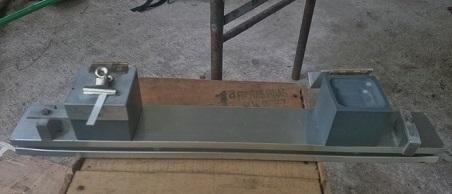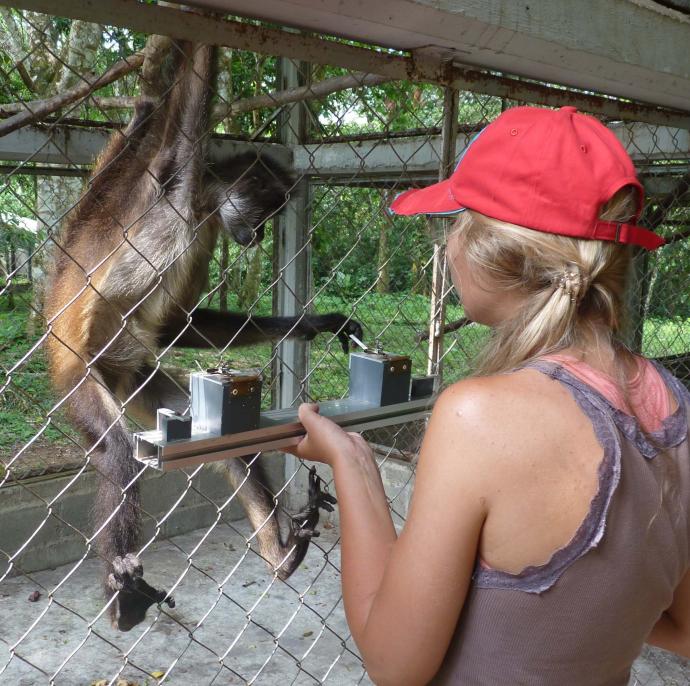Methods
Animals
The study was conducted using 5 adult spider monkeys (Ateles geoffroyi), two males (Gruñón, 11 years and Neto, 7 years) and three females (Margarita, Mary and Paulina, all 8 years). The animals were maintained at the field station Pipiapan of the Universidad Veracruzana, near Catemaco, Veracruz, Mexico. The data were collected between May 2018 and October 2018.
Behavioral test
The method used in the present study is called a food-rewarded two-choice olfactory discrimination paradigm. It is based on an instrumental conditioning procedure in which animals learn to discriminate between two simultaneously presented odor stimuli: a rewarded odor, and a non-rewarded odor. The animals were trained to sniff at two odorized filter paper strips attached to the apparatus (Figure 1) and to use these odor stimuli as cues to identify the rewarded odor. In the case of a correct decision, the animals retrieved a food reward from the apparatus and in the case of an incorrect decision, they were not allowed to correct themselves (and they stayed without food reward). After each decision the apparatus was removed and, out of sight of the animal, prepared for the next trial. Usually 10 trials were conducted per session per animal and each animal performed three sessions a day. The learning criterion was set at 24 correct decisions out of 30 trials (80 %), corresponding to p<0.01 in a two-tailed binomial test. To assess learning speed with a given odor pair, the number of trials an animal needed to reach the criterion was recorded.
The method described here was used in all experiments of the present study: in initial shaping, in intramodal transfer tasks and in assessment of long-term odor memory. Once an animal had learnt to discriminate between the initial odor pair, it was subjected to intramodal transfer tasks where the rewarded odor (positive transfer), the non-rewarded odor (negative transfer) or both the rewarded and the non-rewarded odors (double transfer) were exchanged for novel odorants. Odor memory assessment consisted of presenting an animal after a certain period of time with an odor pair it had previously learnt to the criterion. The odor stimuli used were chosen so that each odor stimulus was qualitatively different from each other based on human perception.

Experimental design
Initial shaping
The initial odor pair that was used to get the animals familiar with the paradigm was n-pentyl acetate (banana-like odorant) as rewarded odor and 1,8-cineole (eucalyptus-like odorant) as non-rewarded odor. The animals were required to reach the learning criterion with the initial odor pair at least three times in total and at least twice in a row before moving on to intramodal transfer tasks.
Intramodal transfer tasks
After an animal had learnt the initial odor pair to criterion, it was subjected to series of intramodal transfer tasks. First a positive transfer was conducted: the first rewarded odor, the banana-like n-pentyl acetate, was replaced by the anise-like anethole while keeping the non-rewarded odor, the eucalyptus-like 1,8-cineole, constant. Once an animal had learnt to distinguish between these two odorants, it was subjected to the first negative transfer: now already learnt rewarded odor, the anise-like anethole, was kept the same and the non-rewarded odor, the eucalyptus-like 1,8-cineole was replaced by the citrus-like (+)-limonene. After an animal had mastered the first negative transfer, it moved on to the second positive transfer and then to the second negative transfer task. After mastering the second negative transfer task, an animal was subjected to several double transfer tasks where both odorants were exchanged for novel ones at the same time. Depending on the learning speed of each individual, the animals went through 0-6 double transfers.
Assessment of long-term odor memory
Long-term odor memory performance was investigated by presenting an animal with odor pairs that it had previously learnt to the criterion after different time periods had passed since a certain odor pair had been presented the last time. Only the individuals that had mastered several double transfer tasks participated in this test and there were memory tasks of 2, 3, 4, 5 and 6 weeks.
Training procedure
Pre-training
As all the animals that took part in the current experiments were unfamiliar with the testing paradigm, the training was done in small steps. The first step was to present the animals with a filter paper strip bearing the first rewarded odor together with a food reward. This was done manually, holding the paper strip close to animals’ nose by forceps and giving the reward using another forceps. Little by little a time gap between presenting of the odorized filter paper strip and giving the food reward was added. After the animals had started to reliably sniff or at least approach the odorized filter paper strip without seeing the food reward first, they moved to the second step. Now the odorized filter paper was attached to one of the two boxes of the apparatus and as soon as an animal approached the filter paper, it was manually rewarded by foreceps. In the third step the food-reward was put inside the test apparatus and upon sniffing at the odorized filter paper, the animal was allowed to open the corresponding box and retrieve the food reward.
Initial shaping
Finally, on the last step the first non-rewarded odor was presented. The apparatus was now equipped with two filter paper strips bearing both the rewarded odor, and the non-rewarded odor, respectively, each attached to one of the apparatus’ two boxes. In most trials the animals were encouraged to sniff both filter paper strips before making the decision but occasionally they were allowed to open the first box they investigated. The animals were only rewarded when they chose to open the box bearing the rewarded odor. From this stage on, the number of trials needed to reach the pre-set learning criterion was recorded (24 correct decisions out of 30 trials, corresponding to 80 % correct decisions). The animals were trained with the initial odor pair until they had learnt the method and when they had reached the learning criterion at least three times in total and at least twice in a row. Then they moved on to the intramodal transfer tasks.

Responsible for this page:
Director of undergraduate studies Biology
Last updated:
05/06/19
